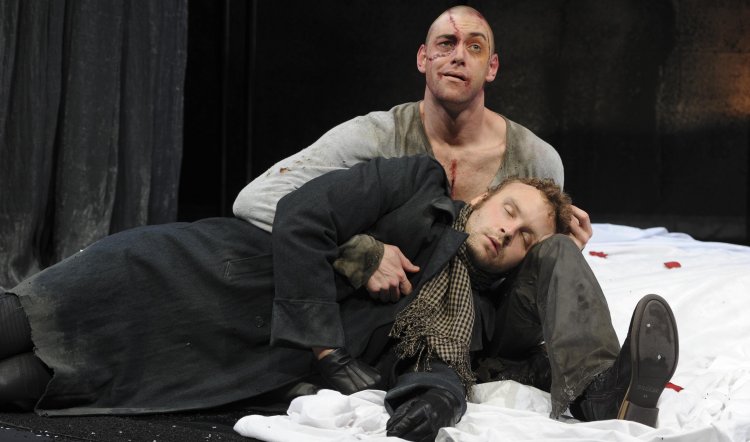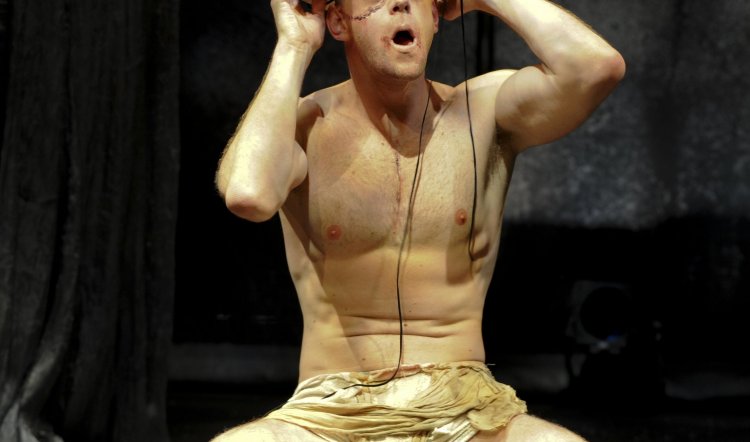
FRANKENSTEIN
FRANKENSTEIN, at the Playhouse, Sydney Opera House, then Ensemble Theatre then touring nationally. 3 April 2013. Photos by Heidrun Lohr; main: Lee Jones and Andrew Henry; right: Lee Jones.
A young (19) Mary Shelley wrote much of Frankenstein while in Switzerland in the summer of 1816 with her lover-then-husband Percy Bysshe Shelley. They were travelling with their friend Lord Byron and his lover (and her step-sister) Claire Clairmont and John Polidori, author of the The Vampyre - the first English vampire story. The hothouse atmosphere radical political thinking, artistic and intellectual curiosity in this group greatly influenced the already liberally if eccentrically educated Mary.
Her story - written at Byron's instigation in competition with the others - incorporated what would later be recognised as science fiction with a Gothic horror story and also a heartrending plea for tolerance in an essentially cruel world. She would surely be bemused by the way the story has become a seminal and widely adapted classic of literature, cinema and pop culture over the close to 200 years since. The men would probably be even more bemused.
This latest reinterpretation of Frankenstein, by English playwright Nick Dear, was first staged by the Royal National Theatre in London in early 2011, to popular and critical acclaim. The Ensemble's co-artistic director Mark Kilmurry secured the rights at the earliest opportunity and this production marks something of a turning point for the venerable Kirribilli-based company. Its Sydney run begins at the Opera House, in the Playhouse, before transferring to the home base and then embarking on a major - 28 venue - tour of Australia. It's a bold adventure that, if there is any justice, will pay handsome dividends - both commercial and artistic - for the little company that could and does.
Kilmurry's staging of Frankenstein is magical and moving. It begins with the casting of Lee Jones, whose brilliance and bravery in the role of Frankenstein's Creature are evident from the opening sequence as electric current and "science" collide to bring to life inanimate flesh and bones. This "birth" is beautiful, challenging, emotionally charged and unforgettable. It is one of the loveliest and most touching answers to the question "what is humanity?" one could imagine.
Ironically however, having given himself over to scientific experimentation, Victor Frankenstein (excellent, brittle Andrew Henry) himself starts to become less than human. He is oblivious to the needs and love of his fiancee Elizabeth (a credible nice girl but proto-feminist Katie Fitchett) and obsessively continues with his goal - to create "a man". And when he does so, he is equally oblivious to The Creature's needs and abandons him, unaware that this man creature will have emotions and desires like any other human being.
Cast out into sparsely populated rural Switzerland, the Creature is greeted by fear, anger, sticks and stones and intolerance at every turn until he meets an old man, De Lacey (sweetly played by Michael Ross). He too has fallen on hard times - losing his home, wealth and livelihood to a military mob and now scratching out a life with his son and daughter-in-law on their poor farm. He is also blind and is therefore the first person not to react with terror at the sight of the scarred face and ungainly movements of the Creature. Nevertheless, his natural kindness and intelligence are attracted to the Creature who is in turn drawn to him. Over time the Creature learns words, he learns to write, he reads Plutarch and they discuss philosophy and much else besides.
The play and Lee Jones' performance reach sublime heights as The Creature begins to see and appreciate the world: the flight of birds, rain on his skin and the satisfaction of food in his gaping, hungry mouth. He discovers his hands and feet and what he can do with them - much like a baby but in a beautifully proportioned, muscular, graceful, adult male body. And then he learns to trust: De Lacy's greatest achievement - and ultimately and unwittingly - betrayal.

The tragedy of the Creature's development is that the more he learns, the more he wants and the less he can have. He enjoys affection, company and the warmth of human interaction, but time and again these are ripped away and he is cast out. When he tells Victor Frankenstein "I am lonely" it is one of the saddest and most painful things ever. But his creator's indifference is total - in his view he is the Master, the Creature is the slave; his needs and emotions mean nothing.
Slavery was still a live topic in England when Mary Shelley wrote Frankenstein. William Wilberforce's Slave Trade Act had become law in 1807, just seven years before. Many wealthy English families and business owners resented the loss of a significant source of that wealth and it was left to artists to depict the horror of slavery. As late as 1847 Charlotte Bronte's Jane Eyre painted an oblique portrait of the beastliness in the traditional English treatment of West Indians. In the novel Jane sees the "mad" woman - Mr Rochester's cruelly confined and exiled first wife - as a savage and a monster; and actually describes her as a "vampire"! She was, of course, the Creole heiress Bertha Mason.
Frankenstein's Creature doesn't even have a name, however, and the terrible consequences of his growing anger are inevitable. He has learned to reason, he has learned to love, but in the end he learns the one thing that truly separates the beast - the Creature - from human beings: he learns to lie. And because of the writing, the character and the playing, it would be a callous person who could condemn him for what he finally does.
Nick Dear's play and Lee Jones' portrayal of the Creature are magnificent and profoundly moving. Mark Kilmurry's work with Jones and the orchestration of the action around him are sensitively and surely handled. The setting (Simone Romaniuk) is simple, effective and atmospheric - and obviously designed to travel, as is the lighting design by Nicholas Higgins. The rest of the cast, including doubling roles by Olivia Stambouliah, Brian Meegan and Michael Rebetzke, will undoubtedly become more focused and sure as they settle around the overwhelming presence of the Creature.
And finally, the electronic soundscape by Daryl Wallis and original music by Elena Kats-Chernin - played live by cellist Heather Stratfold - are a perfect counterpoint and underscore to the story. Peggy Carter's make-up design for the Creature is equally fine - no nuts and bolts or cartoonish horror but a face that a mother could love - and even a lover, if she had a heart.
Frankenstein is a major achievement and a landmark in the Ensemble's history.



